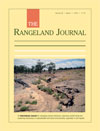RJ11068Impacts of level of utilisation by grazing on an Astrebla (Mitchell grass) grassland in north-western Queensland between 1984 and 2010. 1. Herbage mass and population dynamics of Astrebla spp.
Only one major recruitment event of Mitchell grass occurred during a 26-year grazing experiment at Julia Creek in north Queensland. This recruitment was the result of a particular series of rainfall events and was more or less independent of the degree of utilisation of the Mitchell grass. A utilisation level of 30% resulted in a sustainable Mitchell grassland for the duration of this experiment.




